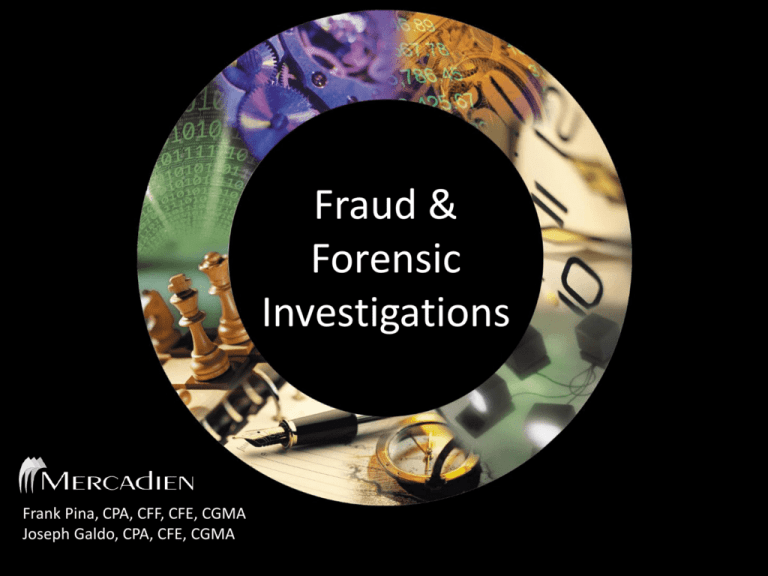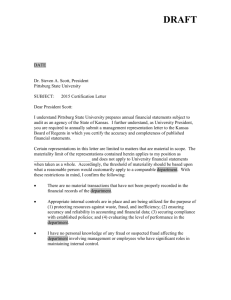Fraud and Forensic Audit Investigations
advertisement

Fraud & Forensic Investigations Frank Pina, CPA, CFF, CFE, CGMA Joseph Galdo, CPA, CFE, CGMA A Statistical Certainty “At any given moment, there is a certain percentage of the population that’s up to no good” -J. Edgar Hoover 2 Fraud Defined Any intentional or deliberate act to deprive another of property or money by guile, deception or other unfair means (ACFE) Deception brought about by misrepresentation of material facts, or silence when good faith requires expression, resulting in material damage to one who relies on it and has the right to do so (IRS) 3 Types of Fraud • Internal Illegal acts of employees, managers and executives against the organization • External Illegal acts of outsiders (i.e., non-employees) against the organization • On the books versus off the books 4 Execution of Fraud • The Act Normally a theft or misrepresentation • The Concealment Once the act is accomplished, efforts must be made to conceal the fraud to prevent detection • The Conversion Once the act is concealed, the perpetrator must convert the asset to his or her own benefit 5 Indicia of Fraud Some clue or hint that someone has misappropriated something… • No written policies and procedures • Overly complex organizational structure • Key employee never takes time off • Management override of controls • Inadequate internal controls/segregation of duties • Incompetent accounting personnel • Indicators are not proof, but what is? Intent goes to proof of fraud 6 Recent Fraud Statistics Typical organizations lose 5% of annual revenues to fraud • Translates to a potential global fraud loss of nearly $3.7 trillion Primary Categories • Asset misappropriations - $130,000 median loss • Corruption - $200,000 median loss • Financial statement fraud - $1 million • Frauds lasted a median of 18 months before detection • Most likely method of detection? • A tip! Source: ACFE 2014 Report to the Nations on Occupational Fraud and Abuse; 2014 Global Fraud Study 7 Fraud Triangle 8 The Perpetrator Pressure/Need Usually an immediate financial need oLiving beyond means oDrug or gambling addiction oHigh personal debts oJob dissatisfaction oEmotional instability oSickness in the family oChallenge to beat the system 9 The Perpetrator Opportunity (perceived) Ability to commit AND conceal fraud –I can do it! –I can conceal it! –I will not get caught! Manifests itself in weak internal controls Lack of oversight Management override of controls 10 The Perpetrator Rationalization Perpetrator justifies actions as something other than fraud, providing a morally acceptable excuse –“I’m only borrowing the money” –“It’s for a good purpose” –“I deserve it” –“Everyone does it” –“I need it more than they do” 11 The Perpetrator A recent study of white collar crime by the Association of Certified Fraud Examiners • College-educated white males • Men committed nearly three-fourths of the offenses 12 The Perpetrator • Possible factors / characteristics Greed Financial difficulties Revenge Compulsive / irrational behavior Employee in position of trust Earnings versus lifestyle Does not take vacations 13 Organizational Vulnerability • Internal controls are weak • Dominated by one or two people • Insufficient working capital • Employees are overworked, poorly paid, with low moral • High turnover rate, especially in accounting group • Poor accounting records / document management • No internal audit function • Poor tone at the top 14 Who should be concerned? • Government regulators • Management (CEO, CFO, Budget Director) • Counsel to companies (internal and external) • Board of directors/trustees • Audit committee • Auditors (internal and external) • Outside lenders (banks and related parties) • Taxpayers • Business owners, including shareholders 15 Typical Fraud Schemes Asset Misappropriation Lapping – A/R Skimming – cash receipts Theft of goods - inventory Ghost employees - payroll False/inflated/duplicate invoices – A/P Ponzi schemes - investments 16 Typical Fraud Schemes Corruption Bribes / Kickbacks o “Things of value” Conflicts of interest Bid Rigging Financial Statement Fraud Improper revenue recognition Overstatement of assets Manipulation of liabilities and/or expenses Improper disclosures 17 Indicators of Fraud • Two sets of books / records • Use of large amounts of and/or frequent use of cash • Incomplete, missing or inaccurate records • Unusual check transactions (multiple endorsements, forgeries, etc.) • Stale items on bank reconciliations • Frequent / suspicious related-party transactions • Lack of adherence to, or absence of policies/procedures/controls 18 Indicators of Fraud • Use of nominees • Use of foreign or off-shore entities or financial institutions • Destruction of records – prematurely or contrary to retention policy • Altered documents: photocopies rather than originals, apparent alterations, duplicate invoices • Numeric documents out of date order • Expense account abuse 19 FORENSIC 20 Why Investigate? What is your goal? • Termination? • Restitution? • Prosecution? 21 Investigative Challenges • Developing effective and efficient investigative strategies o What documents are relevant? o Who to interview? o How to present findings? • Identifying investigative constraints • Determining appropriate resolutions • Improving internal controls (prevention, detection, deterrence) 22 Investigative Scope • Tailor investigative scope / procedures to address: o What happened and during what time period? o Who was involved? o Were they authorized? o How and why did it happen? o What was the impact? o Who needs to know? • Perform the investigation efficiently (cost & time) • Develop remedial actions 23 Investigative Scope • Respond to interested parties (e.g., government agencies, regulators, counsel, etc.) • Also consider: Internal auditor authority Outside forensic assistance Scope limitations Attorney-client privilege 24 Attorney-Client Privilege • The attorney-client privilege exists when a client seeks or receives legal advice from an attorney in confidence. • The communications may be protected forever. The underlying facts, on which the communications are based, are not protected. • The burden of proving the existence of the privilege rests on the party asserting it. 25 Accountant-Client Communications • Federal courts generally do not recognize an accountant-client privilege. • There are various state statutes that do speak to the issue of CPA-client communications/production of documents and afford varying degrees of protection in state courts. 26 Investigative Planning • Understand probative value oKnow your investigative goals –Determine what evidence is useful »Know importance/relevance of information obtained • Evaluate evidence at hand • Be nimble and flexible 27 Document Analysis • What do you want to know? • How do you obtain the information? oVoluntary compliance oRegulatory authority oCompulsory process • Public record information can make a case! oInternet and subscriber databases • Electronic communications oEmails oComputer drives • Interview testimony can be critical! 28 Document Analysis • Financial records and source documents oInvoices oCancelled checks oLedgers and journals oPayroll records oPurchase orders • Financial statements oInternal/external 29 Document Analysis • Forecasts/projections • Tax returns • Confirmation Transactions will be disguised and concealed All records should be suspect! Third-party confirmation to pierce disguise 30 Document Analysis • Transaction tests Fraudsters usually leave a trail o Trail starts with financial records and source documents Detailed and thorough document review necessary o Invoices: authentic/altered or fictitious? o Checks: information on checks can tell the real story o Payroll: false payroll is an easy way to divert funds o Emails: modern-day wire taps! 31 32 Why Interview? “ I can solve ANY case….. no matter how old no matter how complicated no matter how difficult……… If I can get someone to tell me who did it!” ~FBI Instructor, FBI Academy, Quantico, VA, May 10, 1976 33 Why Interview? • Spoken word is the most important source of investigative information • No investigation is complete unless witnesses are interviewed • How do you know if you don’t ask? 34 What are the most important elements of an effective interview? •Preparation! •Preparation! •Preparation! 35 Interviewing • Master all evidence; have it at your fingertips • Draw from previous interviews • Secure, review, integrate and understand the probative value of all available documents: oEmails oFinancial records oData analysis oAll other relevant documents including correspondence, contracts, bid documents, etc. 36 Interviewing • Probe • Conduct interviews to obtain sufficient detail • Do not accept incomplete or unresponsive answers • Ask all questions necessary for required information oAsk until you’re satisfied! 37 Interviewing • Feel free to challenge: Inconsistencies Answers that do not make sense Non-responsive answers Demeanor changes Blatant lies *Fraudsters try to tell 50% of the truth, 100% of the time! 38 Reporting • What is the best way to report your findings? Written report Oral presentation • To whom should you discuss the results? 39 Case Examples QUESTIONS? 41 Contact Information Frank Pina, CPA, CFF, CFE, CGMA fpina@Mercadien.com Joseph Galdo, CPA, CFE, CGMA jgaldo@Mercadien.com 609-689-9700 42





